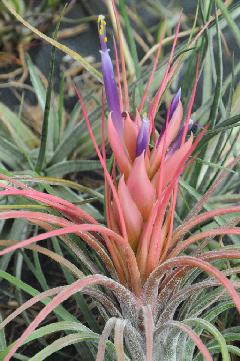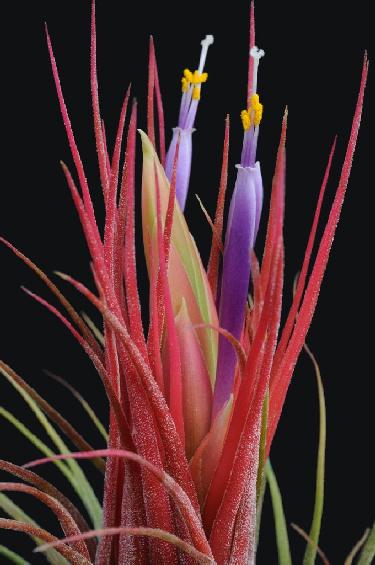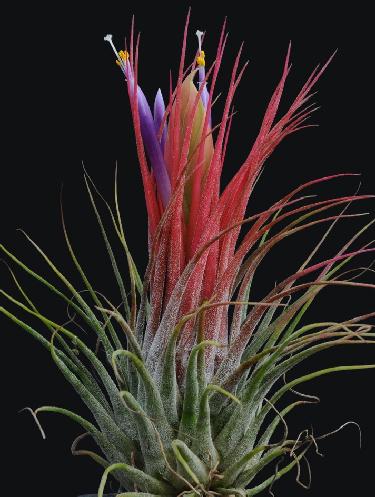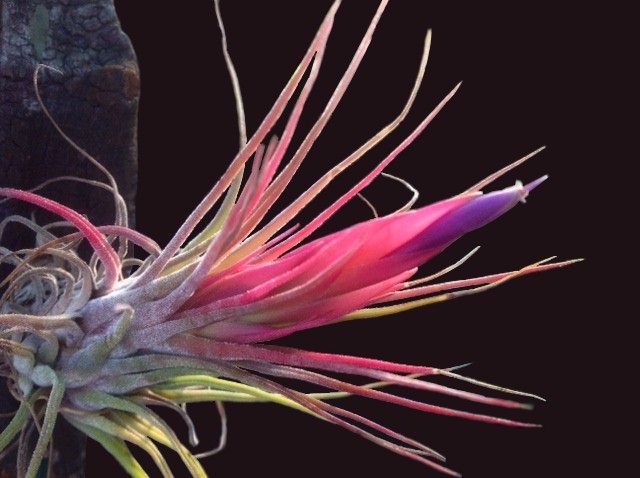







Plant - growing epiphytically, singly or in small groups, stemless, 10-15cm high, 8-10cm diam., forming a narrow, erect, mostly secund pseudobulb, with many (20-40) grey appressed scaled leaves.
Leaves - 5-15cm long, the bottom ones much shorter and almost bladeless, becoming hard and succulent, green, seemingly grey-green because of dense, large scales, the edges with large rough winged trichomes.
Sheath - 3-5cm long, 1-1.7cm wide, oval, spoon-shaped, arched with bent edges, inside green or light brown, outside at the base glabrous, both sides dense grey lepidote, seemingly grey.
Blade - almost distinct from the sheath, 6-10mm wide next to sheath, narrow-triangular tapering to a long filiform tip, almost erect, the edges bent, with indistinct asymmetric keel, green, covered with dense and regular large rough erect whitish-grey trichomes (outside stronger), seemingly grey-green.
Scape - almost missing, 5-10mm long, erect, enclosed and covered by dense imbricate to 3cm long oval sheaths of leaf-like scape bracts, the filiform blades bent outwards, the upper ones with much shorter blade and similar to the floral bracts.
Inflorescence - erect, a little exceeding the rosette, 4-5cm long, 2.5-3cm wide, oval, simple, a distichous almost complanate bright red sword, with 5-11 sessile, densely arranged flowers, the bottom flower sometimes transferred to the middle.
Floral bract - densely imbricate, the flexuous rhachis not visible, 3-5cm long, 1-1.7cm wide, much exceeding the sepals, oval, acute, thin membranous, nerved, not keeled, inside dense and distinctly fine grey lepidote, outside bright dark pink, almost glabrous to weakly appressed scaled.
Sepal - 1.6-2cm long, 5-6mm wide, elliptic, acute, thin membranous with hyaline edges, light green, weakly nerved, fine appressed lepidote, sub-free, the posterior pair joined for 2mm high and keeled.
Petal - 6-7cm long, 6-7mm wide, tapering to 3-4mm at base, forming an erect tube with open throat, the rounded tip bent outwards, upper part light violet or mauve with a lighter tip, the bottom white.
Stamens - exceed the flower;
Filaments in 2 unequally long rows, 6.5-7.5cm long, the upper portion oval, 1mm diam and violet, tapering toward the base and white.
anthers 2-2.5mm long, 1mm wide, sub-basifixed, yellow.
Pollen egg-yellow.
Style 6-6.7cm long, white, upper 2cm lilac.
Stigma 3x3mm. Lobes narrow, white, spreading, papillose, not twisted.
Ovary 5mm high, 3mm wide, oval, light green.
Type - Mexico, State of Oaxaca, between San Gabriel and Sola de Vega, growing epiphytic at 1200-1700 msm. EM 8316 K & R Ehlers March 1983, March 1986. MN 20 Gebruder Noller 1986 sn Gebruder Noller 1987. Jurgen Lautner Feb. 1990 San Gabriel Cerro de Vidrio.
Holotype EM 881501 K & R Ehlers W.U.
Differs from T. kolbii Till & Schatzl by -
Plant - larger, 15 cm high instead of up to 10 cm, building a dense pseudo-bulb.
Leaves - longer, straight, almost erect, not twisted, harder, almost succulent, the sheath distinct.
Inflorescence - distinctly distichous, broader, forming a red sword.
Floral bracts - bright red, almost twice as long (not 1.5 times as long as the sepals, partly 2-3 times as long) not lanceolate partly broad - oval and 3 times as wide, inside distinctly dense with fine grey trichomes, outside glabrous.
Petals - to twice as long, light violet with light tip.
Comments - In the past few years there has been discussion as to whether T. kolbii is identical to T. ionantha v scaposa. From the wide point of view v. scaposa is better as a species in its own right and not a variety of T. ionantha.
T. ionantha v. scaposa L.B. Smith is not endemic to Mexico. It is spread through Central America, all of Guatemala and also comes from San Salvador and Honduras.
The type locality is Guatemala, Antigua, Zacatepec.
The plant is mostly in high areas with temperate, moist climate or in cloud forest, settling predominantly on oak and pine trees.
T. ionantha however grows often in bushes and low lying areas to sea level.
Material studied - From Guatemala EG 920202 near Antigua leg K & R Ehlers Feb. 1992.
Other plants from Guatemala flowering in the Ehlers collection obtained from Meyer & Femo. Widely different plants came from Honduras and San Salvador.
All plants prove to be almost uniform within the normal wide variation.
Plant - an erect, bulbose, green rosette with grey trichomes.
Inflorescence - with a distinct stem, simple, polystichous, (In rare conditions it becomes a compound inflorescence. Comment by Pamela Koide - Do we have a natural hybrid here ?)
laxly elongate with 3-8 flowers,
Floral bracts - 3-3.5 cm long to 7 mm wide, lanceolate acuminate, inside glabrous, outside pink, weak mostly punctulate lepidote.
Sepals - 1.3-1.5 cm long, the posterior ones keeled and joined for a very short way (almost free?), distinctly lepidote.
Petals - 3.5-3.8 cm long, blue-violet.
In the same habitat near the type species is found a different hybrid (T. scaposa x T. rodrigueziana)
T. ionantha v. scaposa L B SMITH is distinguished from T. ionantha PLANCHON v. ionantha by ...
1. Scape distinct.
2. Rosette more lax, erect, and narrower.
3. Leaves broader and softer, laxer with smaller trichomes.
4. Inflorescence laxer, polystichous, and elongated.
5. Sepals exceedingly robust with small grey trichomes.
The many varying morphological characters and the distinct habit brings us to the conclusion that these are species in their own right.
SUMMARY
My proposition is therefore:
T. scaposa L B SMITH status nova
T. kolbii TILL & SCHATZL an independent species